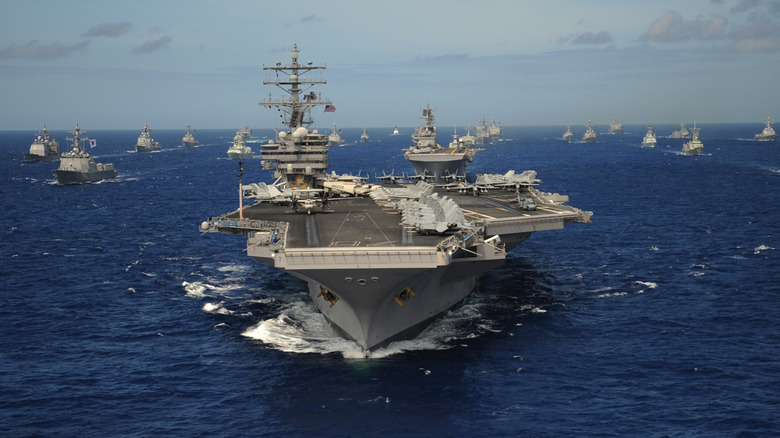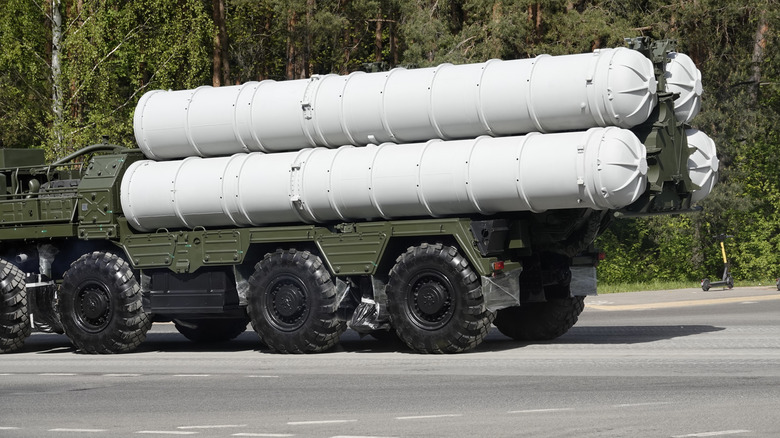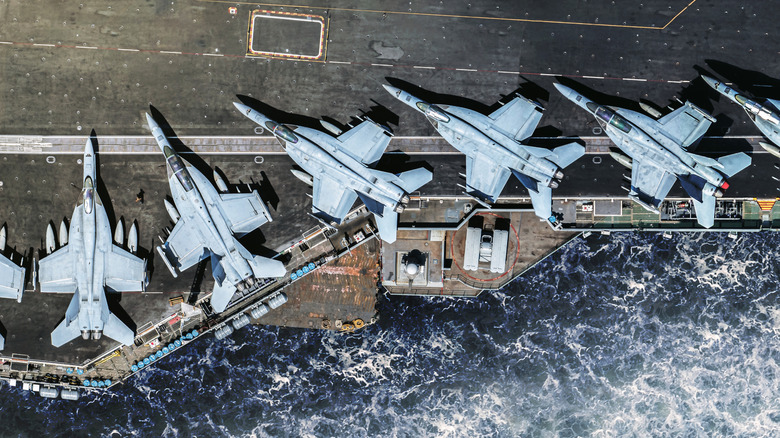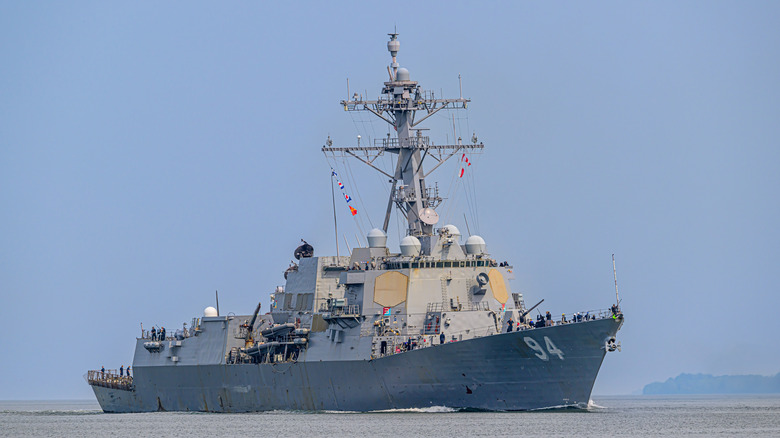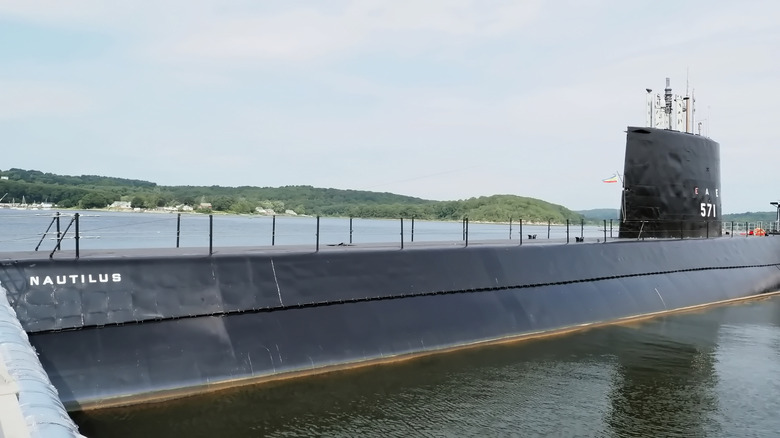Aircraft Carrier Alternatives: These Are The Navy's Best Options
For roughly 100 years, the aircraft carrier has sailed the open ocean. The ship began to take shape in the early 1900s, and the United States' first operational carrier, the USS Langley, launched in 1922. It wasn't the hulking mass of a ship like later aircraft carriers, but USS Langley proved a crucial tool of warfare. There was a use for sea-bound, mobile air power, and it could transform the course of battle across both oceans and nearby shores.
Today, the U.S. operates 11 aircraft carriers, some as long as 1,000 feet and carrying nearly 100 aircraft. They rotate through the Pacific and Atlantic Oceans, with roughly four deployed at a time and four undergoing upgrades, maintenance, and repairs (which can last years at their most intrusive). Other navies around the world also use carriers to support their naval operations. There are 22 aircraft carriers and 51 total carrier vessels on the seas in 2025, with China maintaining three.
However, these powerful floating cities may be losing relevance. Weapons of war are only as good as the countermeasures arrayed against them. For generations, the aircraft carrier defined seaborne supremacy, but that may be shifting. Battle plans that hinge on aircraft carriers face major drawbacks, particularly the huge logistics involved in moving one into position. These are some of the ways that American naval minds are considering replacing or augmenting existing carrier technology to retain its edge.
The primary threat already exists
The conversation surrounding a shift in naval resources focuses on a few key vulnerabilities. For one thing, hulking mega-ships are expensive. A Nimitz-class aircraft carrier (of which 10 American carriers are members) is estimated to cost upwards of $11 billion to produce. The vessel is powered by two nuclear reactors and is the largest naval vessel on the planet. These ships are rated for roughly 50 years of service, and the first (the USS Nimitz) was commissioned in 1975 — 50 years ago in May of 2025. These vessels are slated for a phaseout heading into the future, with Gerald R. Ford-class carriers picking up the baton in their stead.
But larger and therefore slower vessels that provide ever-growing platforms to support other operators may have seen their crescendo already, even as new carriers are expected to enter service in the coming years. New weapons systems are already out in the wild that can seemingly counter a carrier's capabilities.
Russia recently targeted a nearly 3-square-mile Ukrainian missile and rocket facility with an Oreshnik missile. The weapon is a hypersonic missile loaded with numerous conventional payloads. It's functionally a shotgun shell packed into a delivery system that can travel at Mach 11 speeds. Moreover, the missile system appears to be fairly accurate, leading to an assessment that it could be leveraged to deactivate or even destroy an aircraft carrier with a single, well-placed hit. Considering the weapon's blast radius and the sluggish speed of a carrier, it's not outside the realm of possibility, leading to questions of how American naval strategy can adapt, since deflecting or destroying these missiles after launch may be impossible.
Smaller 'flat tops' that retain the carrier's primary function as a combat support system
Shrinkage is perhaps the least inventive solution to the problem of a $30 million missile strike destroying an $11 billion vessel. Instead of continuing to build huge ships that prowl the oceans, the navy could opt for a larger volume of smaller aircraft carriers. The current Nimitz-class carriers can operate with 60-plus jets parked within their hangars. But if instead of four carriers patrolling the oceans, the navy deployed eight that could support 30 aircraft apiece, the fleet might ultimately become more agile, faster to redeploy after repairs and maintenance, and possibly even notably cheaper to build. Of course, this shift would demand significant lead time, especially in light of the existing plans to deploy even larger carriers over the coming years.
Aircraft carriers today are lumbering menaces. They're the largest ships humans have ever put to sea, and they travel fairly slowly for watercraft (30 knots, officially, or about 35 miles per hour). For comparison, the fastest naval vessels on the water are Norway's Skjold-class corvettes, topping out at 69 mph or 60 knots. While speed might not factor into discussions of defense against a scattershot of missile strikes, smaller, faster ships would certainly offer better maneuverability to spread out and cover a greater swath of coastline, sea area, or shipping traffic. For what it's worth, the Navy isn't convinced that this approach would actually bear fruit and deliver value.
A shift toward (much) larger fleets of destroyers
One realistic change that the Navy could employ involves a vessel that's already sailing. Popular Mechanics calls Arleigh Burke-class vessels "the most capable destroyers ever built." With this tool, the U.S. Navy can engage in anti-submarine warfare (without the need for an aircraft like the S-3A Viking), launch anti-ship and air missiles, and even knock satellites out of low-Earth orbit. These vessels cannot launch fighter jets or other planes, but they can support helicopter takeoffs, and a retrofitted destroyer build might offer room for aircraft with VTOL capabilities like the F-35B Lightning II.
Destroyers are agile, capable of spreading out to mitigate threats like that of the Oreshnik missile, and equally able to group in support of a bombardment mission or to protect other vessels. With a much larger fleet of destroyers to replace carriers, the Navy would lose aircraft launch capabilities but gain a potent missile threat that could move more fluidly to cover larger areas. A typical surface action group today consists of five destroyers, bringing nearly 500 missile silos into action. A significantly larger destroyer presence might boost these kinds of typical organized movements to include double or even triple the firepower.
A return to the age of submarine supremacy
Submarine technology has changed substantially in recent decades. HMS Vengeance spent 201 days underwater in 2024, shattering the 120 days that most modern nuclear submarines spend beneath the surface at one time. In theory, a nuclear-powered sub could last for as long as 25 years underwater, so long as its crew stopped needing to eat and the like. Submarines can distill saltwater into clean water for drinking, cooking, and showering, and they can generate breathable air, as well. They are also capable of carrying immense stocks of munitions. If not for resupply and other crew needs, there would be no realistic limit on how long one could remain in the depths.
However, submarines obviously don't offer coverage for helicopter or aircraft takeoffs. There are 71 submarines in the navy's fleet, as of 2024, with most acting in the role of nuclear-powered attack vessels. The key value that these submerged watercraft offer is subterfuge. Moving submarines into position allows for a close-range barrage of offensive weaponry right on the enemy's doorstep. Not only do submarines provide extensive bombardment options, but they can also act as a platform to deploy clandestine personnel to virtually any coastline imaginable.
Submarines remain potent, and the vessels frequently 'sink' aircraft carriers during drills. They're incredibly valuable tools that can take on virtually any ship on the sea. Yet, they also serve as a deterrent by forcing détente through mutually assured destruction. Offensively, as a launch platform for small arms combat, surveillance, and close-proximity barrage, submarines are highly effective.
Shifting the carrier's mission to align closer to remotely piloted and unmanned drone programs
The U.S. military has increasingly relied upon UAVs (Unmanned Aerial Vehicles) to carry out forward strike capabilities in hostile environments. Instead of manned flight, a UAV allows for extreme firepower or surveillance capacity with few of the drawbacks that come from human flight. UAVs like the MQ-9 Reaper can cost less than half the price tag of an F-35 Lightning II and far less than larger bombers. They can stay in the air for upwards of 27 hours and fly at altitudes of up to 50,000 feet, while carrying offensive weaponry and/or surveillance equipment. These drones are an ideal support system to manage all manner of tasks over hostile landscapes.
One interesting angle the Navy could pursue might involve retrofitting aircraft carriers to primarily or solely launch unmanned flight operations. Keeping servicemembers out of harm's way is a key asset of these tools, and one that can change the landscape of what carriers do and how they might be viewed by an enemy during combat. Carriers can house up to 5,000 sailors, making them a massive morale-shifting target beyond the functional value. If such a vessel sank, it would likely cause major casualties, devastate U.S. morale, and prove a powerful boon for the enemy's war effort. Replacing sailors on these huge, enticing targets with fleets of drones could act as a key prioritization shift for enemy strategy.
